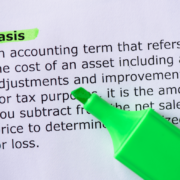ADDITIONAL MEDICARE (HOSPITAL INSURANCE) TAX – HIGH-INCOME TAXPAYERS
The Medicare (aka Hospital Insurance (HI)), tax rate (currently at 1.45%) would be increased by 0.9 percentage points on individual taxpayer earnings (wage withholding and SE tax) in excess of compensation thresholds for the taxpayer’s filing status; see table below. These amounts are not adjusted for inflation, so will remain as shown until changed by Congress.
Wage Withholding – Thus, the wage withholding Medicare rate would be 1.45% up to the income threshold and would be 2.35% (1.45 + 0.9) on amounts in excess of the threshold.
SE Tax – The SE tax rate would be 2.9% up to the income threshold and would be 3.8% (2.9 + 0.9) on amounts in excess of the threshold.
|
All Income Combined for Purposes of the Threshold
For purposes of determining the additional Medicare tax, all wage and self-employment income is combined. For married taxpayers, the spouses’ wages and self-employment incomes are combined. |

Wages – The following details pertain to wage withholding:
o An employer must withhold the additional Medicare tax based upon the wages the employee receives from the employer.
o If the spouse works for the same employer, the employer may disregard the amount of wages received by the employee’s spouse when computing the withholding for either spouse.
o Where a taxpayer has multiple employment, or self-employment and/or the spouse also works, the taxpayer is responsible for the additional 0.9% tax to the extent it is not withheld by an employer and will pay the additional amount on their 1040.
o The employer will not be liable for any additional 0.9% Medicare tax that it fails to withhold and that the employee later pays, but will be liable for any penalties resulting from its failure to withhold.
|
No Additional Tax Imposed on Employers
The entire 0.9% additional Medicare tax is the responsibility of the individual taxpayer and the employer is not required to make a matching contribution. |
Self-Employment Income – The following details pertain to payment of the additional Medicare SE tax:
o The self-employed taxpayer will be responsible for the additional 0.9% Medicare tax. And like an employer will not be liable for the matching amount.
o The SE tax computation deduction continues to be computed using half the sum of the OASDI (Social Security) tax rate and only the regular Medicare tax rate (i.e., 7.65%), without regard to the additional 0.9% Medicare tax.
Reporting Mechanics (Form) – As part of the taxpayer’s Form 1040 filing, the additional Medicare tax is computed on Form 8959 and then that tax and the additional withholding are reconciled to see if the taxpayer owes more tax or is eligible for a credit of excess withholding.
Example – Multiple Employers – Hal has two employers, one of which pays him an annual salary and bonus of $175,000 and the other pays him $75,000. Hal’s wife, Patricia, has wages of $50,000. Their combined wage total is $300,000 but no one employer paid them more than $250,000. Thus, none of their employers withheld any additional Medicare tax, so Hal and Patricia will be responsible for the additional $450 (0.9% of ($300,000 – $250,000)) of Medicare tax when they file their 1040.









Leave a Reply
Want to join the discussion?Feel free to contribute!